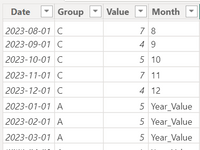FabCon is coming to Atlanta
Join us at FabCon Atlanta from March 16 - 20, 2026, for the ultimate Fabric, Power BI, AI and SQL community-led event. Save $200 with code FABCOMM.
Register now!- Power BI forums
- Get Help with Power BI
- Desktop
- Service
- Report Server
- Power Query
- Mobile Apps
- Developer
- DAX Commands and Tips
- Custom Visuals Development Discussion
- Health and Life Sciences
- Power BI Spanish forums
- Translated Spanish Desktop
- Training and Consulting
- Instructor Led Training
- Dashboard in a Day for Women, by Women
- Galleries
- Data Stories Gallery
- Themes Gallery
- Contests Gallery
- Quick Measures Gallery
- Notebook Gallery
- Translytical Task Flow Gallery
- TMDL Gallery
- R Script Showcase
- Webinars and Video Gallery
- Ideas
- Custom Visuals Ideas (read-only)
- Issues
- Issues
- Events
- Upcoming Events
Calling all Data Engineers! Fabric Data Engineer (Exam DP-700) live sessions are back! Starting October 16th. Sign up.
- Power BI forums
- Forums
- Get Help with Power BI
- Desktop
- Re: How to add a drop down selection to the Total ...
- Subscribe to RSS Feed
- Mark Topic as New
- Mark Topic as Read
- Float this Topic for Current User
- Bookmark
- Subscribe
- Printer Friendly Page
- Mark as New
- Bookmark
- Subscribe
- Mute
- Subscribe to RSS Feed
- Permalink
- Report Inappropriate Content
How to add a drop down selection to the Total annual amount
I have a table with 12 rows for months that show the total sales amount for that month
each month also have a drop down menu with three sections that show 3 diferent product groups with the relevant sales amount.
Below the table is of course the Total number for that year which shows the total sales for all product groups for a whole year
what I want to do is to add similar three product groups below the Total so I can see the annual total for each of the three A, B , C product group. Each of them will show the sales amount for the 12 months.
How do I add that drop down menu below the Total?
Solved! Go to Solution.
- Mark as New
- Bookmark
- Subscribe
- Mute
- Subscribe to RSS Feed
- Permalink
- Report Inappropriate Content
Hi @mamedoff_korea ,
Are you referring to the creation of a column below the Visual Total row to view the information, according to the design of Power BI can not be achieved for the time being, but you can consider the creation of a new table to carry out the operation of the Union, in the row above the Total row to add the information.
Here are the steps you can follow:
1. Create calculated table.
Table2 =
VAR _table1 =
SUMMARIZE (
'Table',
'Table'[Date],
'Table'[Group],
"Value",
DIVIDE (
SUMX (
FILTER (
ALL ( 'Table' ),
YEAR ( 'Table'[Date] ) = YEAR ( EARLIER ( 'Table'[Date] ) )
&& 'Table'[Group] = EARLIER ( 'Table'[Group] )
),
[Value]
),
COUNTX (
FILTER (
ALL ( 'Table' ),
YEAR ( 'Table'[Date] ) = YEAR ( EARLIER ( 'Table'[Date] ) )
&& 'Table'[Group] = EARLIER ( 'Table'[Group] )
&& 'Table'[Month] = [Month]
),
[Value]
)
),
"Month", "Year_Value"
)
VAR _table2 =
UNION ( 'Table', _table1 )
RETURN
_table2
2. Create calculated column.
Rank =
IF (
[Month] <> "Year_Value",
VALUE ( 'Table2'[Month] ),
COUNTX ( ALL ( 'Table2' ), [Value] )
)
3. Create calculated table.
Table3 =
SUMMARIZE ( 'Table2', 'Table2'[Month], 'Table2'[Rank] )
4. Connecting the relationship between two tables.
5. Select Table3[Month] – Column tools – Sort by column – [Rank].
6. Result:
Best Regards,
Liu Yang
If this post helps, then please consider Accept it as the solution to help the other members find it more quickly
- Mark as New
- Bookmark
- Subscribe
- Mute
- Subscribe to RSS Feed
- Permalink
- Report Inappropriate Content
Hi @mamedoff_korea ,
Are you referring to the creation of a column below the Visual Total row to view the information, according to the design of Power BI can not be achieved for the time being, but you can consider the creation of a new table to carry out the operation of the Union, in the row above the Total row to add the information.
Here are the steps you can follow:
1. Create calculated table.
Table2 =
VAR _table1 =
SUMMARIZE (
'Table',
'Table'[Date],
'Table'[Group],
"Value",
DIVIDE (
SUMX (
FILTER (
ALL ( 'Table' ),
YEAR ( 'Table'[Date] ) = YEAR ( EARLIER ( 'Table'[Date] ) )
&& 'Table'[Group] = EARLIER ( 'Table'[Group] )
),
[Value]
),
COUNTX (
FILTER (
ALL ( 'Table' ),
YEAR ( 'Table'[Date] ) = YEAR ( EARLIER ( 'Table'[Date] ) )
&& 'Table'[Group] = EARLIER ( 'Table'[Group] )
&& 'Table'[Month] = [Month]
),
[Value]
)
),
"Month", "Year_Value"
)
VAR _table2 =
UNION ( 'Table', _table1 )
RETURN
_table2
2. Create calculated column.
Rank =
IF (
[Month] <> "Year_Value",
VALUE ( 'Table2'[Month] ),
COUNTX ( ALL ( 'Table2' ), [Value] )
)
3. Create calculated table.
Table3 =
SUMMARIZE ( 'Table2', 'Table2'[Month], 'Table2'[Rank] )
4. Connecting the relationship between two tables.
5. Select Table3[Month] – Column tools – Sort by column – [Rank].
6. Result:
Best Regards,
Liu Yang
If this post helps, then please consider Accept it as the solution to help the other members find it more quickly
Helpful resources

FabCon Global Hackathon
Join the Fabric FabCon Global Hackathon—running virtually through Nov 3. Open to all skill levels. $10,000 in prizes!

Power BI Monthly Update - September 2025
Check out the September 2025 Power BI update to learn about new features.







